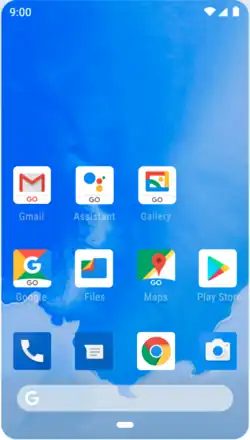Android Go
Android Go, officially Android (Go edition),[1] is a stripped-down version of the Android operating system, designed for low-end and ultra-budget smartphones (but is also used by some tablets[2][3][4]). However, it is intended for smartphones with 2 or less GB of RAM[5] and was first made available for Android Oreo. This mode has platform optimizations designed to reduce mobile data usage (including enabling Data Saver mode by default), and a special suite of Google Mobile Services designed to be less resource and bandwidth-intensive. Google Play Services package was also modularized to reduce its memory footprint.[6] The Google Play Store will highlight lighter apps suited for these devices.[7][8]
 | |
 Android Go 10 home screen with Pixel Launcher | |
| Developer | Various (mostly Google) |
|---|---|
| OS family | Unix-like (modified Linux kernel) |
| Working state | Current |
| Initial release | December 5, 2017 |
| Latest release | 13 (Go edition) / October 19, 2022 |
| Marketing target | Low-end/ultra-budget smartphones (with 2 GB RAM or less) |
| Platforms | ARMv7 (32-bit) |
| Preceded by | Android One |
| Official website | www |
The operating system's interface differs from that of mainline Android, with the quick-settings panel giving greater prominence to information regarding the battery, mobile-data limit, and available storage; the recent apps menu using a modified layout and being limited to four apps (in order to reduce RAM consumption), and an application programming interface (API) for allowing mobile carriers to implement data-tracking and top-ups within the Android settings menu.[6] Some system services are disabled such as Notification access and Picture-in-picture mode to improve performance.
Most devices running Android Go use Google's "stock" Android GUI, although there are several manufacturers that still use customized GUI.
Versions
Android Go was made available to OEMs for Android 8.1, and later, for Android Pie.
| Code name |
Android version numbers |
Minimum RAM required | Android Go release date |
Android release date | Days after release | End of support | Ref. |
|---|---|---|---|---|---|---|---|
| 8.1 (Oreo) (Go edition) | 8.1 | 512 MB | December 5, 2017 | December 5, 2017 | 0 | October 4, 2021 | [9] |
| 9 (Pie) (Go edition) | 9 | August 15, 2018 | August 6, 2018 | 9 | March 7, 2022 | [10] | |
| 10 (Queen Cake) (Go edition) | 10 | September 25, 2019 | September 3, 2019 | 22 | March 6, 2023 | [11] | |
| 11 (Red Velvet Cake) (Go edition) | 11 | 1 GB | September 10, 2020 | September 8, 2020 | 2 | Current | [12] |
| 12 (Snow Cone) (Go edition) | 12 | December 14, 2021 | October 4, 2021 | 71 | [13] | ||
| 13 (Tiramisu) (Go edition) | 13 | 2 GB | October 19, 2022 | August 15, 2022 | 65 | [14] | |
Legend: Old version Older version, still maintained Latest version | |||||||
See also
- Comparison of Android Go products
- Android One, a version of Android originally designed for entry-level and budget devices
References
- "Android (Go edition)". Android. Retrieved 2021-07-02.
- "Lenovo Tab E7 | Easy-to-use entertainment tablet | Lenovo AU". www.lenovo.com.
- "Lenovo Tab E10 | 10.1" family entertainment tablet | Lenovo US". www.lenovo.com.
- "Lenovo Tab M7 (3rd Gen) Specifications" (PDF).
- "Android (Go edition)". Android. Retrieved 2021-06-21.
- "Android 8.0 Oreo, thoroughly reviewed". Ars Technica. Retrieved September 14, 2017.
- ""Android Go" will strip Android down for ultra-low-budget phones". Ars Technica. Conde Nast. Retrieved May 19, 2017.
- "Android Go could help make Android O a runaway success". Engadget. Retrieved May 19, 2017.
- "Introducing Android Oreo (Go edition) with the release of Android 8.1". Blog. Google. 5 December 2017. Retrieved 25 September 2019.
- "Android 9 Pie (Go edition): New features and more options this fall". Blog. Google. 15 August 2018. Retrieved 25 September 2019.
- "More improvements for Android on entry-level phones". Blog. Google. 25 September 2019. Retrieved 25 September 2019.
- "Android 11 (Go edition): New features coming to more devices". Blog. Google. 10 September 2020. Retrieved 10 September 2020.
- A closer look at Android 12 (Go edition).
- "Android 13 (Go edition): Easier to update and tailored just for you". Google. 19 October 2022. Retrieved 19 October 2022.